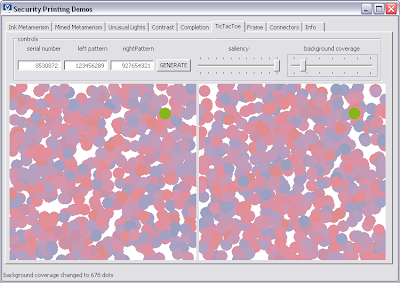As noted on lines 23 and 24 in column 4 of the printed version of patent 8,770,625,
the U.S. Patent Office procedure discourages the use of color drawings. This makes Fig. 4 a little hard to visualize for the non color scientist (there are no color figures in Wyszecki & Stiles), so here it is in color (right pane):

The invention is relatively simple. The general field is anti-counterfeiting as it applies to packaging. Professional counterfeiters have no problem faking ordinary measures like serial numbers and holograms, so the trick is to embed information that cannot easily be perceived by a counterfeiter, hence is omitted in the facsimile. Fortunately color does not exist in nature, it is just an illusion happening in our minds. Therefore, all we have to do is to create an illusion you can only perceive if you expect it.
As described in patent 8,770,625, a number computed from the—possibly counterfeited—serial number on the package can be encoded positionally in a tic-tac-toe grid. The marking is just above the visual threshold, so the naive counterfeiter will reproduce the same pattern on all packages. The trained inspector can then quickly assert whether an actual positional code corresponds, for example, to the possibly fake serial number.
Patent 8,770,625 is relatively short with just three claims, but reducing it to practice is a little tricky, even when all the steps are disclosed in the patent. The difficult part is to design the tool to determine experimentally the visual thresholds for the print process being used and the light conditions under which the inspections are expected to happen. You need to be skilled in the art.
The above figure is a screen-shot of that tool. To implement it you need to write a spectral color management system with CIE colorimetry to simulate the press on the display and vision colorimetry to model what the actual human visual system perceives. The details of the controls are explained in patent 8,770,625.
Depending on your viewing conditions, the above color version of Fig. 4 might be under the visual threshold. If that is the case, in the figure below we crank up the saliency and decrease the background coverage, so you will see the encoding for sure. If you have aliasing problems, you can click on the figures to display them at the original resolution in which they were created eight years ago, early July 2006 (time flies).





No comments:
Post a Comment